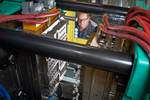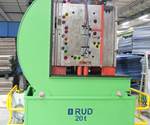Westminster Tool Partners with Sumitomo (SHI) Demag
The Connecticut moldmaker added a new all-electric Sumitomo (SHI) Demag press, boosting its mold qualification capacity and giving the machine maker a New England outpost for sales and training.
Westminster Tool (Plainfield, Conn.) has added a new 354-ton all-electric Sumitomo (SHI) Demag SE-EV-A-HD injection molding machine to bolster its mold qualification and training efforts. A company spokesperson told Plastics Technology that the newest machine will be installed at Westminster’s second facility in Sterling, Conn., which is primarily used for storage and training. The new machine will initiate the process of transitioning mold qualification to Sterling. The Sumitomo (SHI) Demag machine joins 110- and 150-ton Maruka Toyo presses already used in mold qualification and located in Plainfield.
Westminster Tool partnered with Sumitomo (SHI) Demag on the deployment of the machine, noting the new press will specifically accommodate upcoming medical manufacturing projects that feature larger parts and higher cavitation molds. From Sumitomo (SHI) Demag’s perspective, the machine supplier with U.S. headquarters in Georgia specifically sought partners that could help it promote its equipment to the critical New England market.
In addition to mold validation and internal research and development, the machine’s new home at Westminster Tool will also serve as a centralized showcase for potential training, among both companies and their customers.
Westminster’s President Ray Coombs noted the complementary nature of the collaboration in a press release. “Partnering with Sumitomo (SHI) Demag was a natural fit considering the timing, and it’s a perfect alignment of each company’s needs,” Coombs stated.

Ray Coombs, Westminster Tool president (right) and Sumitomo (SHI) Demag North America Business Development Manager, Bob Brady, stand in front of the toolmaker’s newest mold-qualification machine.
Photo Credit: Westminster Tool
Related Content
-
How to Design Three-Plate Molds, Part 1
There are many things to consider, and paying attention to the details can help avoid machine downtime and higher maintenance costs, and keep the customer happy.
-
Using Data to Pinpoint Cosmetic Defect Causes in Injection Molded Parts
Taking a step back and identifying the root cause of a cosmetic flaw can help molders focus on what corrective actions need to be taken.
-
Back to Basics on Mold Venting (Part 2: Shape, Dimensions, Details)
Here’s how to get the most out of your stationary mold vents.





